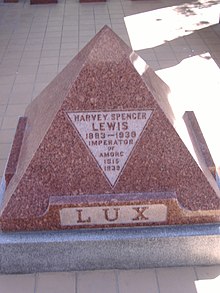Harvey Spencer Lewis
Harvey Spencer Lewis | |
|---|---|
 | |
| Born | November 25, 1883 Frenchtown, New Jersey, United States |
| Died | August 2, 1939 (aged 55) |
| Organization | AMORC |
| Title | Imperator of AMORC |
| Term | 1915–1939 |
| Successor | Ralph Maxwell Lewis |
| Children | Ralph Maxwell Lewis |
Harvey Spencer Lewis (November 25, 1883 – August 2, 1939), a Rosicrucian author, mystic and founder of AMORC. He lead AMORC as its first leader (imperator) from its creation in 1915 until his death.
Early life
[edit]Lewis was born November 25 1883 in Frenchtown, New Jersey.[1] His parents were of Welsh and German ancestry.[1] Lewis was an advertising agent.[2]
Esotericism
[edit]He had founded a group called the New York Institution for Psychical Research. In 1904 he founded the Rosicrucian Research Society.[2][3] The Ancient Mystical Order of the Rosy Cross (AMORC) was founded in 1915.[3][4] He founded the organization after a trip to France with his father, claiming that he had been initiated into Rosicrucianism and was given a mission to spread it there in what he called an "old tower" in Toulouse.[3][1] He presented this as a revival of the original, partially mythical and ancient Rosicrucian Order.[5]
Lewis affiliated with many occult groups, especially Aleister Crowley's Ordo Templi Orientis.[4] Following a 1916 split in the O.T.O., the schismatic German branch recognized AMORC, giving him a document to prove this. He was proud of receiving this document, despite differences in belief between the two organizations (AMORC did not practice sex magic).[4] While predominantly Rosicrucian, the works of Lewis also incorporate neo-Templar elements, having a particular interest in the 18th century revivalist order of Bernard-Raymond Fabré-Palaprat and the Knights Templar. Lewis had had some contact with neo-Templar figures and related European occultists, including Émile Dantinne.[5]
Lewis was interested in Egyptology, and founded the Rosicrucian Egyptian Museum in San Jose. It is located in Rosicrucian Park.[4]
Works
[edit]In 1931, Lewis, under the pen name Wishar S[penle] Cerve, wrote a book (published by the Rosicrucians) about the hidden Lemurians of Mount Shasta that a bibliographic note on Mount Shasta described as "responsible for the legend's widespread popularity."[6][7] Lewis authored The Mystical Life of Jesus in 1929. The book is notable for defending a variant of the swoon hypothesis that Jesus survived his crucifixion. Lewis plagiarized entire chapters from The Aquarian Gospel of Jesus the Christ by Levi H. Dowling.[4][8]
Death
[edit]
Lewis died in 1939. He was succeeded as leader of AMORC by his son, Ralph Maxwell Lewis.[2][3]
Bibliography
[edit]- Rosicrucian Principles for the Home and Business (1929)
- Explains portions of Rosicrucian teachings and philosophy as related to work and personal goals.
- Rosicrucian Questions and Answers with Complete History of the Order
- A two-part book: Part One gives the "traditional" history of the Rosicrucian Order, with names and works; Part Two answers common new member and prospective member questions.
- The Mystical Life of Jesus
- A retelling of the life story of Jesus; reportedly plagiarized Levi H. Dowling's Aquarian Gospel.
- Lemuria, The Lost Continent Of the Pacific (1931), as Cerve, Wishar S.
- The Secret Doctrines of Jesus
- An explanation of many symbols, standards, and interpretations of the work of Jesus and the Twelve Apostles.
- A Thousand Years of Yesterdays
- A fictional story, explaining reincarnation as a man re-experiences past selves.
- Self Mastery and Fate with the Cycles of Life
- Relates the Cycles of Life system, similar in nature to biorhythm.
- Rosicrucian Manual (1918, 1929 with reissues)
- Explains the structure of AMORC and includes everything a new Rosicrucian should know.
- Mansions of the Soul: The Cosmic Conception
- Essays about Life, Death, the Afterlife, and Rebirth.
- The Symbolic Prophecy of the Great Pyramid
- Presents an interpretation of Egyptian symbology, with old and new ideas discussed.
- Mental Poisoning
- An examination of curses, hexes, and psychic manipulation.
References
[edit]- ^ a b c Edighoffer 2005, p. 692.
- ^ a b c Chryssides 2006, pp. 30–31.
- ^ a b c d Introvigne 2004, p. 30.
- ^ a b c d e Melton 1987, p. 593.
- ^ a b Caillet 1997, p. 29.
- ^ Meisse 1993, p. 146.
- ^ Melton 1999, p. 332.
- ^ Chryssides 2006, pp. 37–38.
- Sources
- Caillet, Serge (1997). L'Ordre rénové du Temple: Aux racines du Temple solaire (in French). Dervy. ISBN 978-2-85076-924-5.
- Chryssides, George D. (2006). "Aquarian Gospel of Jesus the Christ, The". The A to Z of New Religious Movements. The A to Z guide series. Lanham: Scarecrow Press. ISBN 978-0-8108-5588-5.
- Edighoffer, Roland (2005). "Lewis, Harvey Spencer". In Hanegraaff, Wouter J.; Faivre, Antoine; Broek, R. van den; Brach, Jean-Pierre (eds.). Dictionary of Gnosis & Western Esotericism. Leiden; Boston: BRILL. ISBN 978-90-04-14371-5.
- Introvigne, Massimo (2004). "AMORC". In Clarke, Peter (ed.). Encyclopedia of New Religious Movements. Routledge. ISBN 978-1-134-49970-0.
- Meisse, William C. (1993). "Legends: Lemuria". Mount Shasta: An Annotated Bibliography. College of the Siskiyous.
- Melton, J. Gordon, ed. (1999). "LEWIS, Harvey Spencer". Religious Leaders of America: A Biographical Guide to Founders and Leaders of Religious Bodies, Churches, and Spiritual Groups in North America (2nd ed.). The Gale Group. ISBN 978-0-8103-8878-9. ISSN 1057-2961.
- Melton, J. Gordon, ed. (1987). "Ancient and Mystical Order of the Rosae Crucis". The Encyclopedia of American Religions (2nd ed.). Gale Research. ISBN 978-0-8103-2133-5.
Further reading
[edit]- Serge Cailler, "L'affaire Spencer Lewis", Renaissance traditionnelle, n° 101/102, 1995, pp. 72-87
- Robert Vanloo, Les rose-croix du nouveau monde. Aux sources du rosicrucianisme moderne, Paris, Claire Vigne, 1996.
